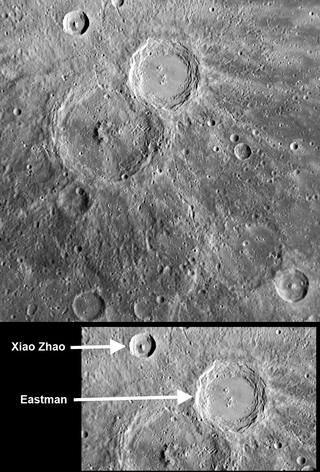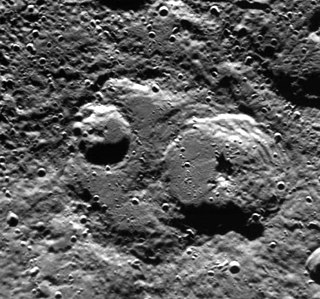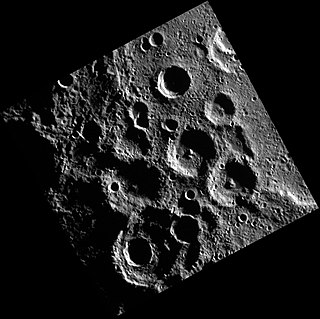
de Gerlache is a lunar impact crater that is located along the southern limb of the Moon, within a crater diameter of Shackleton at the south pole. From the Earth this crater is seen from the edge, and it lies in perpetual darkness. Thus little or no detail can be seen of this crater, other than the edge of the rim. However, the crater is clearly visible in Earth-based radar images. The crater is roughly circular, with some slight wear. No craters of note overlie the rim, although some formations may be attached to the southern and western edges.

Aristoxenus is an impact crater near the north pole on Mercury. It was named by the IAU in 1979 after the Greek philosopher Aristoxenus.

Matisse is an impact crater on the southern hemisphere of Mercury. Matisse takes its name from the French artist Henri Matisse, and it was named by the IAU in 1976.

Raphael is a crater on Mercury. Its name was adopted by the International Astronomical Union (IAU) in 1976, and is named for the Italian painter Raphael.

Verdi is an impact crater on the planet Mercury. It was named after Italian Romantic composer Giuseppe Verdi (1813–1901) in 1979, as recognized by the International Astronomical Union. The crater's extensive ejecta blanket and secondary crater field are superposed on plains materials and older craters.

Izquierdo is a crater on Mercury. Its name was adopted by the International Astronomical Union (IAU) in 2009, for the Mexican painter María Izquierdo. The floor of Izquierdo is smooth, the result of having been partially filled with volcanic lava. Circular outlines of the rims of “ghost craters” – smaller, older craters that have been largely buried by the lavas that infilled the basin – are visible in a few places on Izquierdo's floor. The remnants of a buried inner ring are also barely discernible in spots, and it is one of 110 peak ring basins on Mercury. There have been more recent impacts into the floor of Izquierdo, resulting in some small, sharply defined craters.

Eastman is a crater on Mercury first seen by MESSENGER during the mission's first Mercury flyby. Eastman exhibits some features characteristic of a fresh, relatively young crater. The walls of Eastman have clearly visible terraces, and the central peak structure is well preserved. Eastman is located near Xiao Zhao crater.

Matabei is an impact crater on Mercury. It has a set of dark rays. Dark rays are rare on Mercury, but other occurrences have been identified, such as at Mozart crater. Mozart crater is interpreted to have excavated dark material from depth during the impact event, creating dark streamers. The dark rays from Matabei may have a similar origin.

Ahmad Baba is a crater on Mercury. It has a diameter of 127 kilometers. Its name was adopted by the International Astronomical Union (IAU) in 1979.

Jókai is a crater on Mercury. Its name was adopted by the International Astronomical Union (IAU) in 1979. Jokai is named for the Hungarian novelist Mór Jókai, who lived from 1825 to 1904.

Li Chʻing-Chao is a crater on Mercury. It has a diameter of 61 kilometers. Its name was adopted by the International Astronomical Union (IAU) in 1976. Li Chʻing-Chao is named for the Chinese poet Li Qingzhao, who lived from 1081 to c. 1141.

Tolkien is one of the northernmost craters on Mercury, located in the Borealis quadrangle at 88.82 N, 211.08 W. It is 50 km in diameter. It was named after the South African born British writer J. R. R. Tolkien. The name was approved by IAU's Working Group for Planetary System Nomenclature on August 6, 2012. Since Tolkien is very close to the north pole, and Mercury has almost no axial tilt, Tolkien receives very little sunlight. S band radar data from the Arecibo Observatory collected between 1999 and 2005 indicates a radar-bright area covers the entire floor of Tolkien, which is probably indicative of a water ice deposit.

Magritte is a crater on Mercury, near the south pole. This crater was likely created by an impact event, as evident by its circular depression. Its name was adopted by the International Astronomical Union in 2012, after the Belgian painter, René Magritte. Magritte is one of several craters on Mercury named after famous artists. Per the Working Group for Planetary System Nomenclature, all Mercury craters are named after an artist who was famous for more than fifty years who has been deceased for more than three years at the time the crater is named.

Petőfi is a crater on Mercury, near the south pole. Its name was adopted by the International Astronomical Union in 2013, after the Hungarian poet Sándor Petőfi, following the official convention of naming craters on Mercury after historically significant artists, musicians, painters, and authors.

Scopas is a crater on Mercury, near the south pole. Its name was adopted by the International Astronomical Union in 1976, after the ancient Greek sculptor and architect Scopas, following the official convention of naming craters on Mercury after historically significant artists, musicians, painters, and authors.

Sadī is a crater on Mercury. Its name was adopted by the International Astronomical Union (IAU) in 1976, after Persian poet Saadi Shirazi.

L'Engle is a crater on Mercury, located near the south pole. Its name was adopted by the International Astronomical Union (IAU) in 2013, after American author Madeleine L'Engle.

Lovecraft is a crater on Mercury, located near the south pole. Its name was adopted by the International Astronomical Union (IAU) in 2013, after American author Howard Phillips Lovecraft.

Kobro is a crater near the south pole of the planet Mercury. Its name was adopted by the International Astronomical Union (IAU) on the December 12, 2012. Kobro is named for the Polish sculptor Katarzyna Kobro. It is adjacent to Komeda crater, which was named at the same time.

Komeda is a crater near the south pole of the planet Mercury. Its name was adopted by the International Astronomical Union (IAU) on the December 19, 2012. Komeda is named for the Polish composer Krzysztof Komeda. It is adjacent to Kobro crater, which was named at the same time.



















